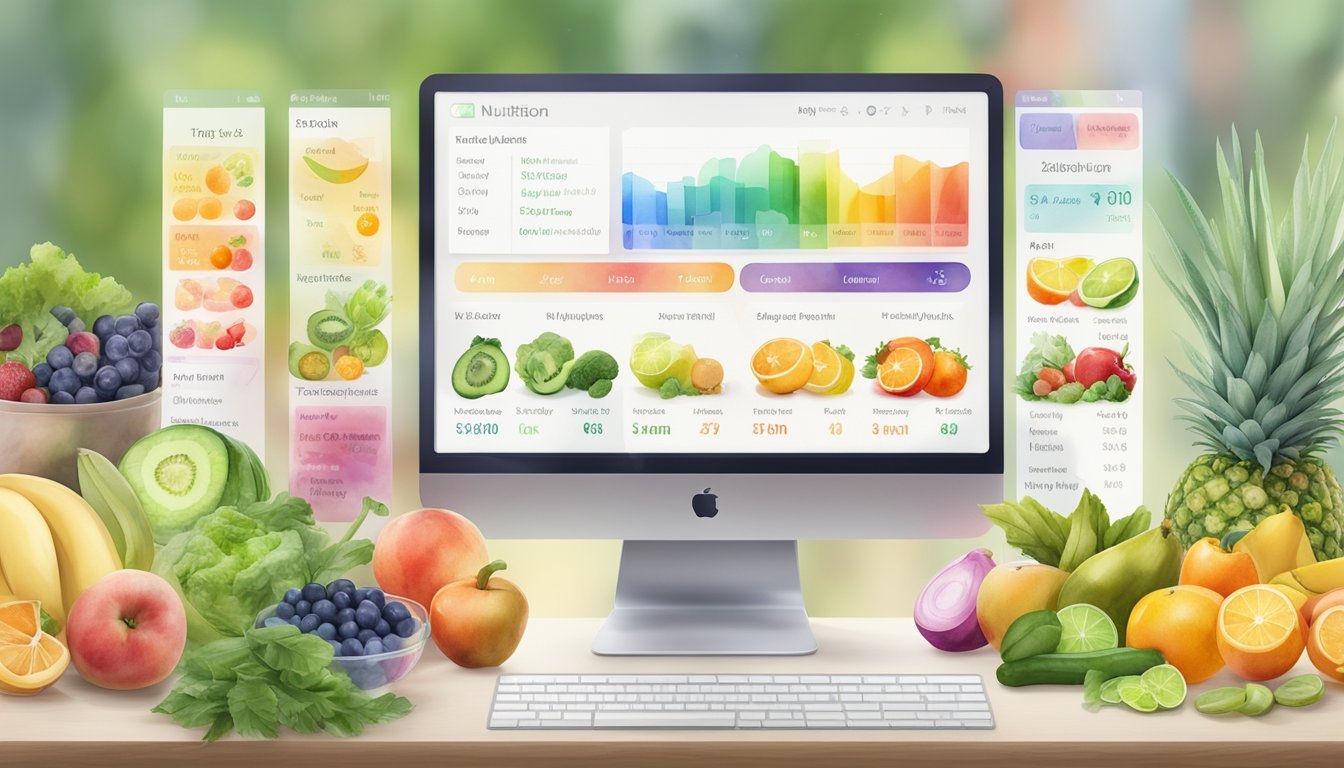Personalized Diet and Nutrition Plans: Your Next Side Hustle

In today’s fast-paced world, maintaining a healthy diet can be challenging.
Personalized nutrition and meal plans offer a solution that takes your unique needs and lifestyle into account. Personalized diet plans can adapt to your individual health goals and even help you save time and money.

Imagine having a meal plan that not only aligns with your dietary preferences but also fits neatly into your busy schedule.
With the rise of technologies like AI-powered diet planners, creating nutritious and tailored meal plans has never been easier.
These tools consider your food preferences, allergies, and even your budget to develop the perfect plan just for you.
Getting started with personalized nutrition can be a game-changer for your health and wellness journey.
Whether you aim to lose weight, gain muscle, or manage a health condition, a customized approach can make all the difference. By incorporating personalized meal plans into your routine, you’ll find it easier to stick to your dietary goals and enjoy the process.
Key Takeaways
- Personalized meal plans cater to your unique dietary needs and lifestyle.
- Technology makes creating and following a customized diet plan simple and efficient.
- Tailored nutrition can help you achieve specific health goals more effectively.
The Science of Personalized Nutrition
Personalized nutrition tailors diets based on individual differences in genetics and lifestyle.
By understanding how your body responds to different foods, you can improve your health more effectively.
Understanding Personalized Nutrition
Personalized nutrition looks at each person’s unique characteristics.
Regular nutrition advice tends to group people together, but personalized plans consider things like genetic makeup, lifestyle choices, and health goals.
For example, nutrition based on your needs can help reduce salt intake and improve the quality of dietary fats.
This can lead to better outcomes for managing weight and other health parameters.
Mainly, personalized nutrition focuses on what works best for you rather than a one-size-fits-all diet.
It’s about finding the right balance and making you feel healthier.
The Role of Genetics and Lifestyle
Genetics play a crucial role in how your body reacts to different foods.
For example, people with certain genetic markers may process fats, carbohydrates, or vitamins differently.
Using genomics, personalized nutrition can tailor a diet plan that fits your DNA.
This approach can improve nutrient absorption and balance.
Yet, it’s not just about genes.
Your lifestyle, including physical activity and stress levels, affects how your body utilizes nutrients.
Integrating both genetics and lifestyle factors helps create a well-rounded nutrition plan.
Making changes based on this knowledge could mean better managing weight, improving energy levels, and supporting overall health.
By considering both genetics and daily habits, personalized nutrition aims to make the most effective and lasting impact.
Assessing Your Dietary Needs

You need to consider several factors to create a diet plan that suits you best.
These include health goals, age, sex, weight, and body mass index (BMI).
Understanding these elements can guide you in making healthier food choices.
Importance of Health Goals
When assessing your dietary needs, your health goals are crucial.
Do you want to lose fat, gain muscle, or maintain your current weight? Knowing what you want helps in choosing the right foods.
If your goal is weight loss, you’ll focus on eating fewer calories than you burn.
Foods rich in fiber and protein can help you feel full longer, making it easier to stick to your plan.
For muscle gain, your dietary needs will include more protein and perhaps a higher calorie intake.
Tailoring your diet to your goals ensures you’re giving your body what it needs.
Factoring in Age and Sex
Your age and sex play significant roles in determining your dietary requirements.
As you age, your metabolism slows down, which means you might need fewer calories.
Additionally, nutritional needs vary between men and women due to different body compositions and hormonal balances.
Children and teenagers, still growing, need more calories and nutrients compared to adults.
Women may need more iron, especially during menstruation, pregnancy, and menopause.
Men may need more calories due to higher muscle mass.
Eating according to your life stage ensures you’re meeting your body’s changing needs, helping you stay healthy and active.
Influence of Weight and BMI
Understanding your weight and BMI can help you assess your dietary needs better.
BMI is a measure that uses your height and weight to estimate body fat.
Knowing your BMI helps you determine if you need to gain, maintain, or lose weight.
For those with a higher BMI, reducing calorie intake while increasing physical activity is often recommended.
Those with a lower BMI might need to focus on nutrient-dense foods to gain weight healthily.
Keeping an eye on your weight and BMI provides useful data for adjusting your diet.
It helps you make informed choices to achieve your health goals, whether that’s losing fat, gaining muscle, or simply maintaining your current state.
Common Dietary Considerations

When personalizing your diet, it’s crucial to address specific dietary needs and preferences.
This includes allergies, dietary choices like vegan or paleo, and requirements for gluten-free diets.
Addressing Allergies and Intolerances
Managing allergies and intolerances is a must for personalized nutrition plans.
Common food allergies include peanuts, tree nuts, milk, eggs, wheat, soy, and shellfish.
Even small amounts of these allergens can trigger severe reactions.
To make your diet work, always read labels and understand alternative food options.
For instance, if you’re allergic to dairy, you might use almond milk or oat milk instead.
Keep an EpiPen handy if you have severe allergies.
Using apps and tools to track your food intake can help manage these concerns efficiently.
It can also be easier to manage meals if you prepare them yourself or choose restaurants that cater to specific dietary needs.
Choosing Between Vegan and Paleo
Selecting between a vegan and paleo diet can be a struggle, especially when balancing nutrient intake.
Vegans avoid all animal products, focusing on plant-based foods such as vegetables, fruits, grains, and legumes.
Key nutrients to monitor include B12, iron, and protein.
Nutritional yeast, chickpeas, and tofu are good sources.
Paleo diets, by contrast, include meat, fish, vegetables, and nuts, while avoiding grains, legumes, and processed foods.
The focus is on whole, unprocessed foods similar to what early humans might have eaten.
It’s crucial to include a variety of meats and plenty of vegetables to ensure a well-rounded nutrient intake.
Depending on your lifestyle, healthcare needs, and ethical beliefs, choosing the right path can make a significant difference.
Always consider consulting a dietitian to ensure you’re meeting all your nutritional needs.
Considerations for Gluten-Free Diets
Gluten-free diets are essential for people with celiac disease or gluten sensitivity.
Gluten is a protein found in wheat, barley, and rye.
It can cause digestive issues and other symptoms in sensitive individuals.
When following a gluten-free diet, focus on naturally gluten-free foods like fruits, vegetables, meat, fish, and dairy.
Many grains like rice, quinoa, and oats (if certified gluten-free) are good alternatives.
It’s also important to check food labels meticulously as gluten can be hidden in sauces, dressings, and processed foods.
Products labeled “gluten-free” are safer choices, and numerous apps can help identify suitable products.
Avoiding cross-contamination in kitchens where gluten-containing foods are prepared is also vital for maintaining a strict gluten-free diet.
Creating Your Diet Plan
Designing a personalized diet plan involves considering meal patterns, ensuring a balanced intake of macronutrients, and incorporating superfoods to boost health.
This process can help meet your nutritional goals and improve your overall well-being.
Setting Up Meal Patterns and Portions
Begin by determining how many meals and snacks you want each day.
Some people thrive on three main meals, while others prefer three meals with small snacks in between.
Make sure to keep portions appropriate.
A practical way to do this is by using your plate as a guide:
- Half the plate: Vegetables and fruits
- One-quarter: Protein sources like chicken, fish, or tofu
- One-quarter: Whole grains or starchy vegetables
Tailor this setup to maintain a steady energy level throughout the day and avoid overeating.
Incorporating Macronutrients
Balancing macronutrients is key to a healthy diet. Proteins, carbohydrates, and fats each play a vital role in your body’s function.
For proteins, aim to include sources like lean meats, beans, or dairy in each meal.
This will help with muscle repair and growth.
When it comes to carbohydrates, prioritize whole grains, fruits, and vegetables.
These offer sustained energy and essential nutrients.
Don’t forget healthy fats.
Avocados, nuts, and olive oil are great sources that support brain health and hormone production.
Inclusion of Superfoods for Optimal Health
Adding superfoods can boost your diet plan’s effectiveness.
Examples of superfoods include berries, spinach, and quinoa.
Berries provide antioxidants that protect your cells from damage. Spinach is packed with iron and vitamins, which support your immune system and energy levels. Quinoa, a high-protein grain, supplies essential amino acids and fiber.
Integrate these foods into your meals:
- Top your breakfast oatmeal with berries.
- Add a handful of spinach to your smoothies.
- Use quinoa as a base for salads or side dishes.
Incorporating superfoods regularly can enhance your overall health and keep your diet interesting.
Meal Planning and Prep
Meal planning and prepping can save time, help you eat healthier, and even reduce grocery bills.
With proper strategies, you can streamline your weekly routine and avoid stress.
Crafting a Weekly Meal Plan
Creating a weekly meal plan involves deciding what you’ll cook for each meal.
Start by thinking about your schedule.
Do you need quick breakfasts or dinners you can make in 30 minutes?
List your favorite recipes first.
Choose a mix of proteins, veggies, and grains.
Balance new recipes with tried-and-true favorites to keep things interesting.
Remember to account for leftovers – they’re lifesavers for busy days.
Pro Tip: Apps like Eat This Much can help you generate personalized meal plans based on your preferences and goals.
Shopping Smart with Grocery Lists
Once your meal plan is set, create a detailed grocery list.
This saves you from multiple trips to the store and helps you stick to your budget.
Organize your list by store sections – produce, dairy, meats, and pantry items.
Don’t forget basics like spices, oils, and condiments.
They can make or break your dishes.
If you’re often rushed, consider grocery delivery services; they’re a great convenience.
Highlight: Using apps like PlateJoy can automatically generate grocery lists to fit your meals, reducing waste and making shopping efficient.
Prepping Meals to Save Time
Meal prepping means doing a bit of work upfront to save more later.
After you shop, wash and chop veggies, marinate meats, and cook grains in bulk.
Store them in labeled containers in your fridge or freezer.
This way, you can quickly assemble meals throughout the week.
Pre-cooked items can be mixed and matched for variety.
For example, grilled chicken can be used in salads, wraps, or paired with rice.
Tip: Investing in quality containers keeps food fresh longer and ensures easy access and portion control.
By combining these elements, you’ll find meal planning and prepping fit smoothly into your routine, making healthy eating more accessible and less time-consuming.
Technology in Personalized Nutrition

Advances in technology are transforming how you create and follow a personalized diet and nutrition plan.
From using mobile apps to track meals to utilizing blood sugar sensors for real-time monitoring, technology is making it easier to manage your health.
Using Apps for Tracking and Planning
Using mobile apps is becoming a popular way to manage personalized meal plans.
Apps like Zoe use an extensive database to help you select meals based on your unique dietary needs.
These apps can track your calorie intake, monitor macros, and even suggest recipes.
They can also log daily physical activity, ensuring you maintain a balanced lifestyle.
Some apps integrate seamlessly with wearables, giving you comprehensive health data at your fingertips.
Moreover, these tools can send reminders for meal times and notify you about your hydration levels.
Customizable settings allow you to set personal goals, whether you want to lose weight, gain muscle, or maintain your current health status.
The Emergence of Blood Sugar Sensors
The rise of blood sugar sensors is another exciting development in personalized nutrition.
Devices like continuous glucose monitors (CGMs) give you real-time data on your blood sugar levels.
This information is crucial, especially if you have diabetes or other metabolic conditions.
Sensors can alert you when your levels are too high or low, allowing you to adjust your diet immediately.
They often sync with apps, providing a seamless experience for managing your health.
Blood sugar sensors can help you understand how different foods impact your body.
By analyzing this data, you can optimize your diet to maintain stable blood sugar levels and improve overall well-being.
Knowing your body’s response helps you make informed choices, enhancing the effectiveness of your personalized nutrition plan.
Incorporating Fitness into Your Nutrition Plan

Combining fitness with your nutrition plan can help you achieve better health results.
Aligning your meal plans with your workouts and balancing your calorie intake with physical activities are key aspects to consider.
Aligning Workout Plans with Meal Plans
Matching your meals with your workout schedule can improve your energy levels and performance.
Eating the right foods before and after exercise is essential. Pre-workout meals should be rich in carbohydrates and protein, giving you the energy to power through your session.
Think about having a banana and a small serving of yogurt.
For your post-workout meal, focus on protein and carbs to help your muscles recover and replenish energy.
A good option could be grilled chicken with brown rice and vegetables.
Tailoring your meals like this helps you make the most of your workouts and can support your body’s needs.
Planning your workouts around your mealtime ensures you have enough fuel to sustain your energy levels.
For morning workouts, a light breakfast like oatmeal with fruit can be beneficial.
If you exercise in the evening, a balanced lunch prepared with lean protein, whole grains, and veggies can keep you energized.
Balancing Calories with Physical Activities
Knowing how many calories you need to consume and burn each day is crucial for your fitness goals.
If you’re looking to lose weight, you’ll need to create a calorie deficit by eating less and exercising more.
If you’re aiming to build muscle, you might need more calories to support muscle growth.
It’s important to track your activity levels and adjust your calorie intake accordingly.
Tools like fitness trackers or apps can help you monitor your daily steps, workouts, and calories burned.
This data can be used to fine-tune your meal plans.
Incorporating different types of exercise, such as strength training at the gym or cardio sessions, can also influence your calorie needs.
On days with more intense workouts, you may need to eat more calories to maintain your energy.
Make sure to balance your nutrients as well, focusing on protein, healthy fats, and carbs.
Eating Habits and Mental Health
Your eating habits can greatly influence your mental health by affecting your mood and stress levels.
Good nutrition plays a key role in managing stress and boosting your mood.
Role of Diet in Stress Management
What you eat can help manage stress.
Foods rich in omega-3 fatty acids, like salmon and chia seeds, can lower stress levels.
These foods help reduce the hormones that cause stress in your body.
Whole grains like brown rice and oatmeal release serotonin.
This is a brain chemical that makes you feel good.
On the other hand, too much sugar can make you feel more stressed.
When you eat sugary snacks, your blood sugar levels rise quickly and then drop, leaving you feeling tired and more stressed.
Sticking to a balanced diet with plenty of fruits and vegetables helps maintain steady energy levels.
Avoiding processed foods and sugary drinks can also make a big difference in how you handle stress day-to-day.
Nutrition and Its Impact on Mood
Eating nutritious foods improves your mood and mental health.
A diet rich in fruits, vegetables, and whole grains supports brain health.
These foods provide vitamins and minerals that your brain needs to function well.
For example, leafy greens like spinach and kale are packed with folate, which helps manage mood.
Foods with probiotics, like yogurt and sauerkraut, benefit your gut health.
A healthy gut can lead to a happy mind since it’s connected to your brain.
On the flip side, poor nutrition can worsen mental health issues like depression and anxiety.
Eating a variety of nutritious foods can give you more energy and help you feel better mentally.
Balancing your diet by including healthy fats, lean proteins, and complex carbohydrates makes it easier to keep a positive outlook.
Tracking Progress and Adjustments
Regularly tracking your progress and making timely adjustments are key to the success of your personalized diet and nutrition plan.
This approach ensures your plan remains aligned with your goals, such as weight loss or managing blood sugar levels.
Evaluating the Efficiency of Your Diet
Regular evaluations help you determine if your diet is effectively tailored to your goals.
Use nutrition-tracking apps to log your meals and monitor macro and micronutrient intake.
Apps like these provide valuable data on how your food choices impact your weight, blood sugar, and energy levels.
Another useful method is keeping a food journal.
By documenting what you eat, you can identify patterns and triggers that influence your eating habits.
Comparing this information with your physical and emotional well-being allows for better decision-making.
Additionally, lab tests can be insightful.
Regular blood tests help assess how your diet affects your glucose levels, cholesterol, and other markers.
This information can confirm whether your dietary plan is working or if adjustments are needed.
When to Revise Your Nutritional Approach
It’s essential to adjust your nutritional plan based on consistent progress tracking.
If you find that you are not losing weight as expected, it might be time to revise your approach.
Small tweaks like adjusting portion sizes or changing nutrient ratios can make a big difference.
Progress plateaus are common.
When you hit one, it might be useful to consult with a dietitian.
They can provide expert advice on modifying your diet for better results.
Incorporating new foods or cutting out less nutritious ones can help break the plateau.
Regularly checking in on your energy levels and overall health is also important.
Feeling unusually tired or noticing fluctuations in your blood sugar might indicate the need for changes in your diet.
Keeping your plan flexible ensures it remains effective and aligned with your health goals.
Community and Support

Getting a personalized nutrition plan is great, but having a community and a dedicated nutritionist makes it even better.
These elements keep you motivated and on track.
Finding Support in Online Communities
Joining online communities can be an excellent way to get support.
Facebook groups and forums have become popular places.
For example, the Lumen Facebook group has over 60,000 members sharing tips and experiences.
Discussing your goals and challenges with like-minded people can be very encouraging.
You can get advice on meal prep, find new recipes, and share progress.
Using email newsletters from these groups can keep you informed and motivated.
Community support is about creating connections and sharing knowledge.
Working with Nutritionists
Teaming up with a nutritionist offers professional guidance tailored to your needs.
They can review your dietary information and create a personalized nutrition plan for you, enhancing your overall health journey.
Platforms like Project Lean Nation provide one-on-one coaching, ensuring that your nutritionist understands your unique needs.
This personal touch can make a big difference.
They can also adjust your plan based on your progress.
Regular check-ins can help you stay focused, and their knowledge can help you navigate any obstacles.
Working with a nutritionist offers professional and customized support, essential for achieving your dietary goals.
Special Considerations

When planning personalized diets, it’s crucial to address unique needs during specific life stages or medical conditions.
This ensures that nutritional benefits are maximized for health and wellness.
Diet during Pregnancy and Nursing
Pregnancy and nursing bring unique nutritional demands.
You need extra calories, vitamins, and minerals to support your baby’s development and your health.
Focus on an eating pattern that includes a variety of foods.
Incorporate folic acid (found in leafy greens) to reduce birth defects, and iron (from lean meats) to prevent anemia. Calcium (from dairy or fortified plant-based milk) supports bone health.
Stay hydrated and limit caffeine intake.
Avoid alcohol and certain fish high in mercury, as they can harm your baby.
Nutrition for Disease Management
Personalized nutrition is vital in managing diseases like type 2 diabetes and stroke recovery.
For diabetes, monitoring carbohydrate intake is crucial.
Aim for whole grains, which have a lower glycemic index, ensuring steady blood sugar levels.
For stroke recovery, include omega-3 fatty acids (found in fish) to improve brain health and reduce inflammation. Antioxidant-rich foods (such as berries) can help with cellular repair.
Limit salt to manage blood pressure, and focus on fiber-rich foods to support cardiovascular health.
Tailoring your diet based on these needs can significantly impact disease outcomes and overall wellness.
Frequently Asked Questions

Creating a personalized diet plan doesn’t have to be expensive or time-consuming.
There are various ways to customize your diet to fit your needs and goals without breaking the bank.
How can I create a personalized diet plan without spending any money?
Start by tracking your daily food intake and identifying areas to improve.
Use free apps like MyFitnessPal to log your meals and monitor your nutritional intake.
Look for online resources that offer free meal-planning templates and advice.
Where can I find a free, personalized diet and workout plan that suits my needs?
Websites like Custom Daily Diet offer plans tailored to your food preferences, budget, and schedule.
They even consider your physical condition and activity levels.
Many fitness blogs and forums also provide free plans based on different goals like weight loss or muscle gain.
Are there any free diet plan PDFs that I can use as a starting point for weight loss?
Yes, many health websites and blogs offer free PDFs that include diet plans for weight loss.
These plans often come with meal suggestions, grocery lists, and portion sizes.
Check out popular nutrition blogs for downloadable guides.
What’s the best way to gain weight with a customized diet plan?
Focus on calorie-dense, nutritious foods like avocados, nuts, and whole grains.
Using tools like Custom Daily Diet can help you create a meal plan suited to gaining muscle or adding healthy weight.
Ensure you’re consuming more calories than you burn and include protein-rich foods.
How do I tailor a diet plan to meet my specific nutrition requirements?
Conduct a thorough assessment of your current health status.
Blood tests can reveal nutritional deficiencies, which you can address by adjusting your diet.
Working with a registered dietitian can also provide targeted advice to meet your specific needs.
What tools can help me generate a meal plan that fits my dietary goals?
Use apps like MyFitnessPal and Cronometer to track your daily nutritional intake.
Websites like Custom Daily Diet and Dietitians also offer tools to create meal plans based on your goals, whether it’s losing weight, maintaining weight, or building muscle.

